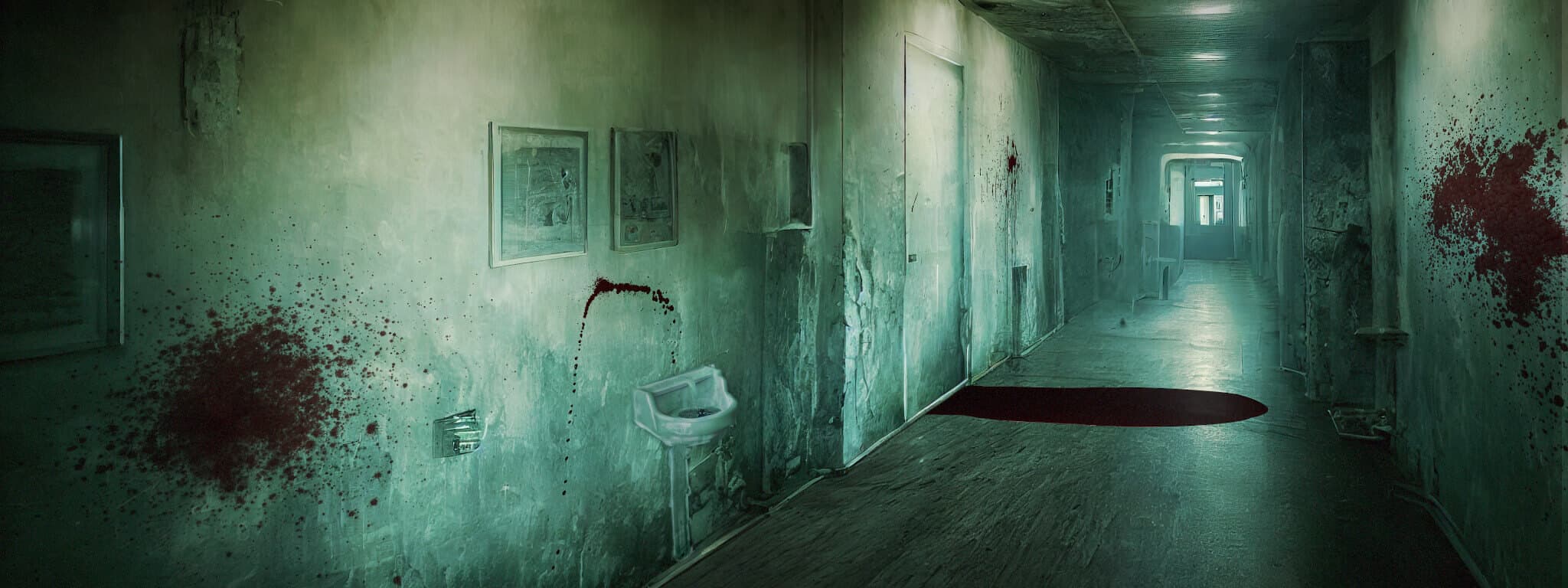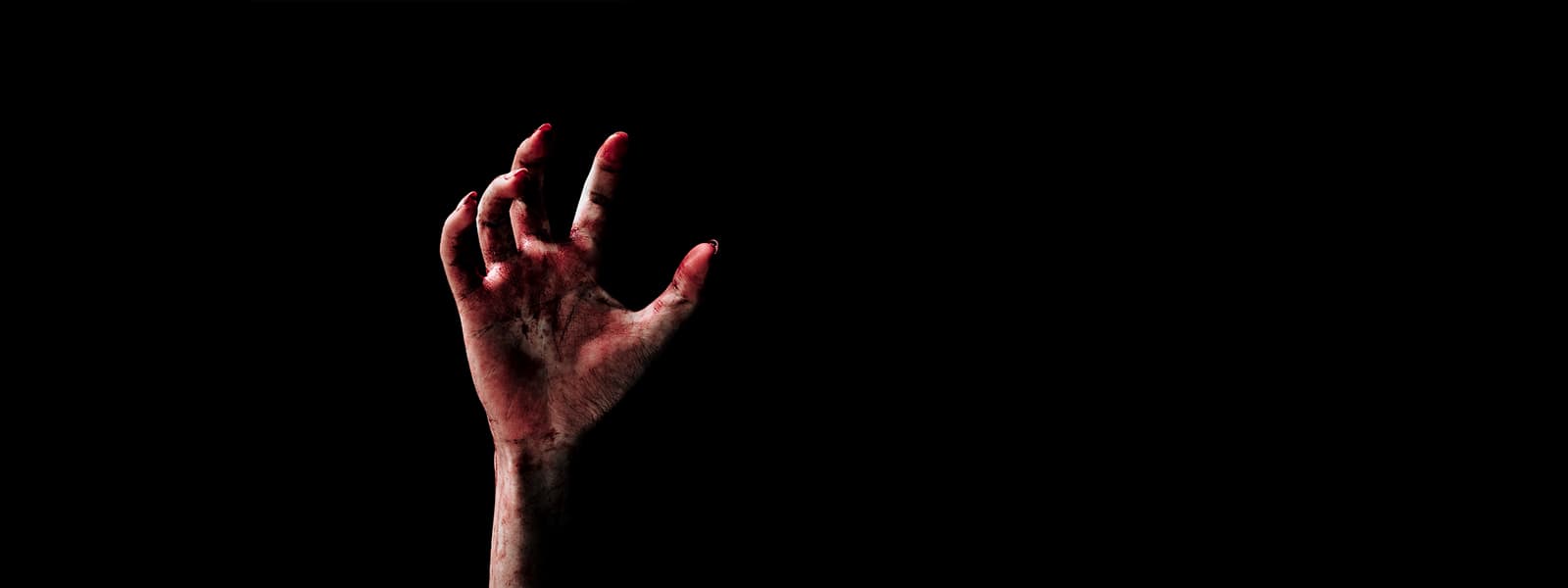
How to Make Fake Blood Like a Professional
Iconic Fake Blood Recipes from the Masters
Fake blood recipes can be some of the most difficult recipes to track down. They are often incomplete, conflicting, and without a definitive source. Most online videos involve a host winging it by mixing ingredients in unmeasured amounts until the fake blood looks “right.” There’s nothing wrong with this if you’re just having fun, but what happens when you need to create a second or third batch of blood that matches exactly for continuity?
We’ve tracked down the most trustworthy sources we could find and have compiled some of the best recipes for realistic fake blood used throughout cinema history.
Whether it’s for a Halloween costume party or special makeup effects in a feature film, if you need to make fake blood, you’ve come to the right place.
Making Fake Blood
With all of these fake blood recipes, you’ll need a few household kitchen utensils to mix and prepare your bloody concoctions.
Basic supplies:
- Large mixing bowl
- Medium mixing bowl
- Liquid measuring cup
- Kitchen scale (or dry measuring cups)
- Rubber Spatula (or something to stir with)
- Spare plastic containers
- Paper towels
For reference, we have presented the original recipes intact (as much as possible), but for our updated adaptations, we have converted measurements to metric units and adjusted all the formulas to create 1 liter of fake blood. This amount should be more than enough for most uses and is easy to scale up if you need more.
Also, some of these recipes contain ingredients that are either dangerous or hard to come by, but luckily, they can be updated with a few ingredients that can easily be found in any grocery store. So, we’ll be providing you with both the historical fake blood recipes and our updated recipes that use safer and more commonly available ingredients.
Black and White Blood
CHOCOLATE SYRUP BLOOD
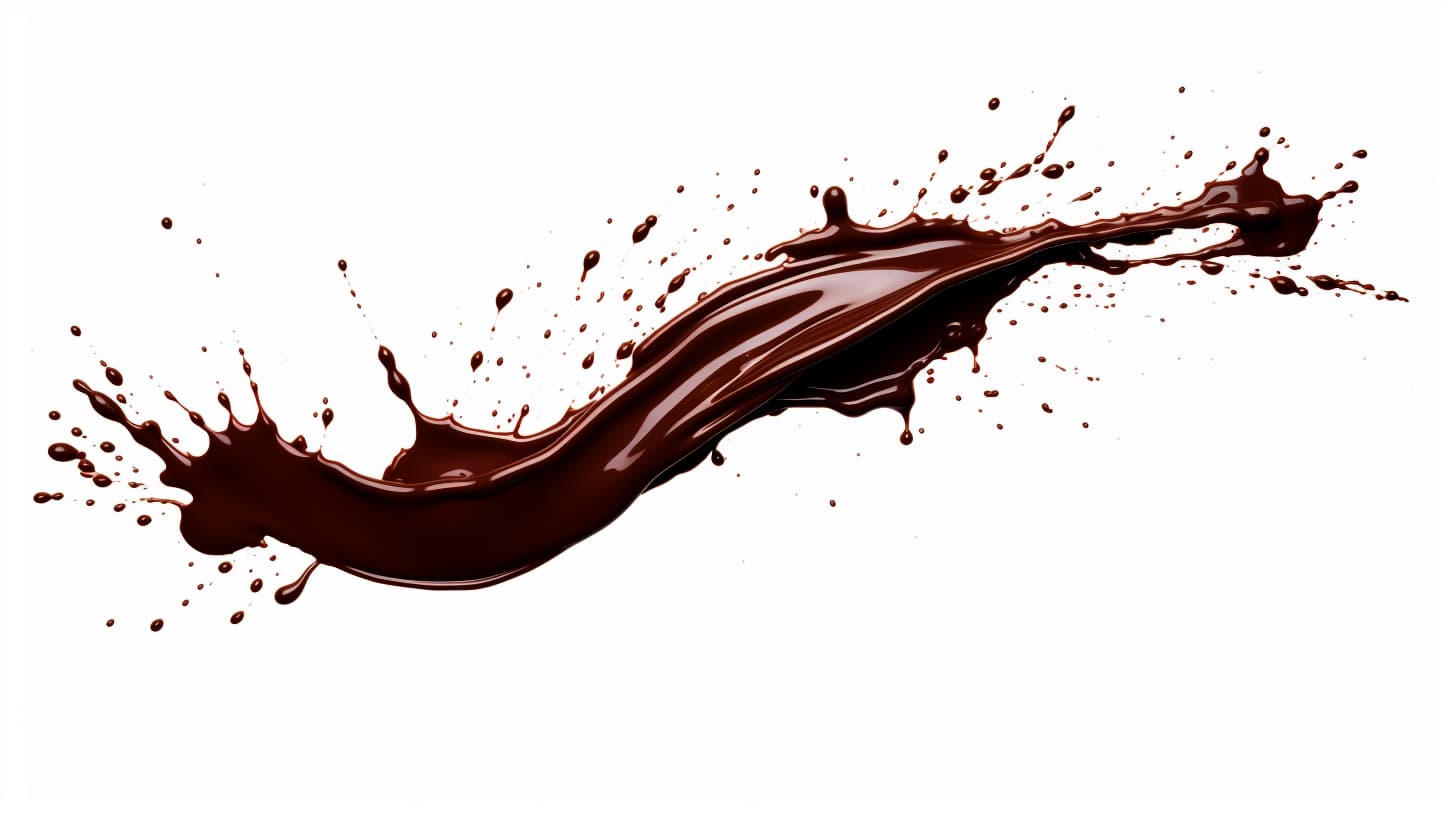
An easily accessible fake blood material that filmmakers turned to in the black-and-white era was simple chocolate syrup.
Legendary director Alfred Hitchcock famously utilized chocolate syrup to great effect in his 1960 thriller Psycho. The shocking shower scene features chocolate syrup washing down the drain, appearing strikingly like blood in black and white.
George A. Romero also famously deployed chocolate syrup blood in his 1968 zombie classic Night of the Living Dead. The black and white cinematography accentuated the gore as survivors battled the undead.
Chocolate Syrup Recipe:
- 1 bottle of chocolate syrup
- Tap water (to thin as needed)
Compared to ingredients, chocolate syrup was cheaper and simpler to use straight out of the bottle. Plus, it allows for edible fake blood that is safe to use on actors! The thick, opaque liquid naturally exhibited qualities similar to blood on camera, particularly in monochrome.
Water can be used to dilute and create a less viscous fluid when the chocolate is too thick on its own.
Hammer Films Blood
Kensington Gore
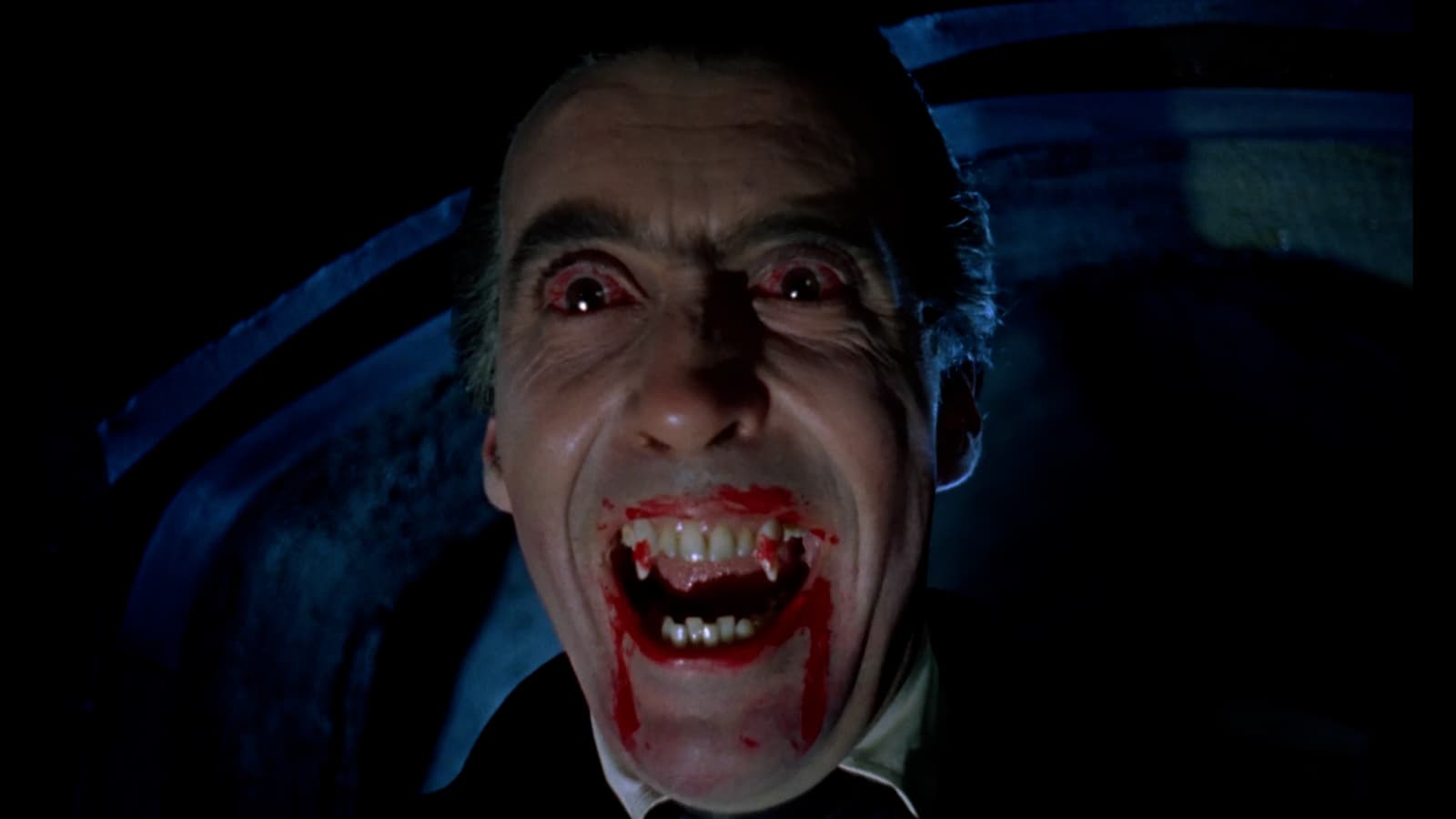
After decades of censorship that limited graphic content, blood and gore began emerging more prominently in films starting in the 1950s. Small independent studios took advantage of loosening restrictions to produce low-budget horror and exploitation films that emphasized bloodshed and violence.
In the United Kingdom, Hammer Film Productions led the way with color remakes of classic monster movies that splashed blood across the screen. Their 1957 film The Curse of Frankenstein kicked off a series of lurid horror, showcasing a bright red blood substance called Kensington Gore.
Original Kensington Gore Recipe
- 2 Parts golden syrup
- 1 Part water
- An ample amount of red food coloring
- A few drops of yellow food coloring
- A few drops of blue food coloring
- Corn flour
- Mint extract
Instructions:
- In the large mixing bowl, combine the golden syrup and corn flour. Mix until thoroughly uniform in texture.
- Add the red food coloring, followed by the yellow food coloring, and continue to mix.
- Combine the water and blue food coloring and continue to stir until fully integrated.
- Check the blood on some scrap cloth and skin. If it’s too thick, add more water to thin it out, conversely if it is too thin, add more golden syrup.
This famous blood recipe produces the bright red blood that became the signature of Hammer horror films and their shocking gore. Kensington Gore struck an optimal balance between appearance and functionality that set the standard in the movie industry until the 1970s.
Created by retired pharmacist John Tynegate, this viscous, syrupy blood recipe used a base of golden syrup for thickness and shine, and food coloring provided a vivid red color.
To adjust the thickness and prevent an overly runny consistency, the Kensington Gore formula includes corn flour (cornstarch in the US). However, too much cornstarch can cause an unnatural lumpy or bubbly texture and opaque appearance, so restraint is key.
Finally, peppermint oil is substituted over mint because it can help to deter flies and other insects. The minty flavor also provides a better experience for actors getting the blood in their mouths. One of the nice things about Kensington Gore is that it is an edible fake blood that is safe for actors to use.
The Godfather of Fake Blood
Dick Smith's Recipe
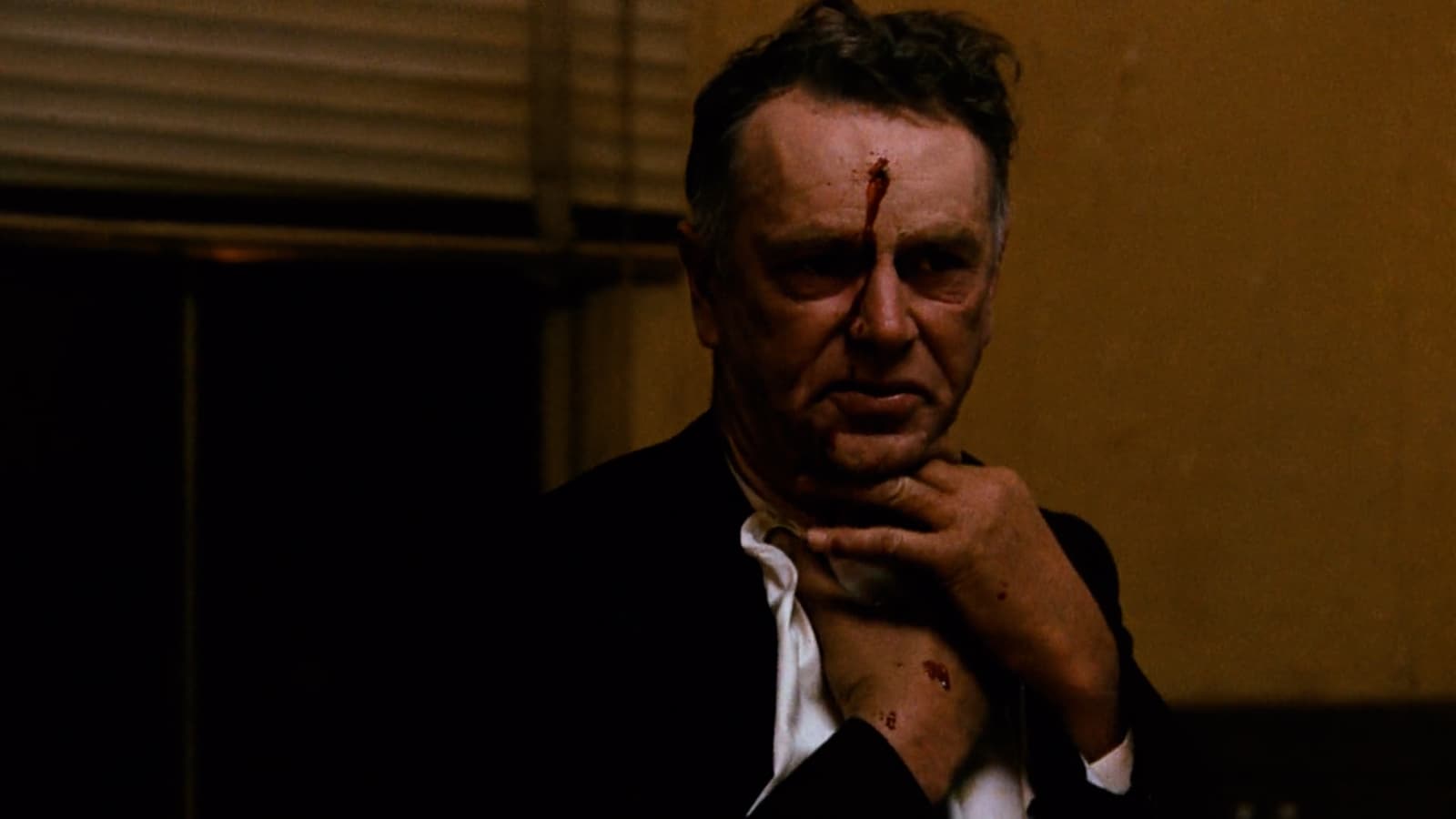
In the 1970s, acclaimed special effects artist Dick Smith developed a fake blood formula that would become the industry standard for decades to come. Smith’s innovative concoction was first used in major Hollywood films like The Godfather, The Exorcist, and Taxi Driver.
Here is the Dick Smith blood recipe as cited by Pasquale Murena and our updated (non-poisonous) version:
Original Dick Smith Formula
- 1 Quart White corn syrup
- 1 Oz. Of Water
- 1 Tsp Zinc Oxide
- 1 Tsp Methylparaben (to prevent mold)
- 6 Tsp Ehler Red Food Colour
- 1 Tsp Ehler Yellow Food Colour
- 1 Oz. Kodak Photo-Flo (to reduce surface tension – Poisonous)
Instructions:
- Start by mixing your dry powders (zinc oxide and methylparaben) with a small amount of water in a medium mixing bowl. The goal here is to create a smooth paste and slowly all of the remaining water without leaving any dry clumps or lumps.
- Add the lecithin, red, and yellow food colors and continue to mix.
- In a large mixing bowl, combine the corn syrup and the red paste that you have created. Combine slowly, fully integrating the paste into the corn syrup, creating a smooth and consistent texture.
- Conduct color and consistency tests on small pieces of scrap cloth and the back of your hand. If the solution appears too thick, you may consider adding a bit more water to achieve the desired texture.
Dick Smith’s recipe builds upon and improves the Kensington Gore blood recipe. Rather than golden syrup used in Kensington Gore, Smith’s recipe relied on the more accessible (in the US) corn syrup as its viscous base.
Smith perfected this recipe to strike an optimal balance of appearance, texture, and functionality. It provided filmmakers the ability to drench the screen with seemingly realistic blood. The handy corn syrup base and realistic colors made Dick Smith’s formula the definitive blood recipe in Hollywood special effects for years to come.
The corn syrup base gives the fake blood body, viscosity, and gloss. Powdered food coloring provides vibrant, semi-opaque colors. Zinc oxide gives thickness without dulling shine. Notably, the Dick Smith formula doesn’t call for any blue food coloring. However, you might find the need to deepen the color with a drop or two of blue.
In our interpretation, we have substituted lecithin (or a few drops of dish soap) for the poisonous Photo-Flo. These chemicals serve as an emulsifier that breaks the surface tension, allowing realistic dispersion and spreading across the skin. Shoutout to John Hess of Filmmaker IQ for this expert tip!
This balanced combination of (mostly) household ingredients allowed Smith to produce the convincing blood featured in classics like The Godfather and Taxi Driver, cementing his recipe as the go-to standard in Hollywood special effects.
Free Blood VFX
Sometimes, the blood on set just doesn’t come out the way you want, but that’s okay because we’ve got your back.
Low-Budget Horror Classic
Evil Dead's Fake Blood
Evil Dead Fake Blood Recipe (adjusted)
- 750 ml clear corn syrup
- 150 ml water
- 300 g Non-Dairy Creamer
- 100 ml Red Food Colour
- 1 Drop of Blue food coloring
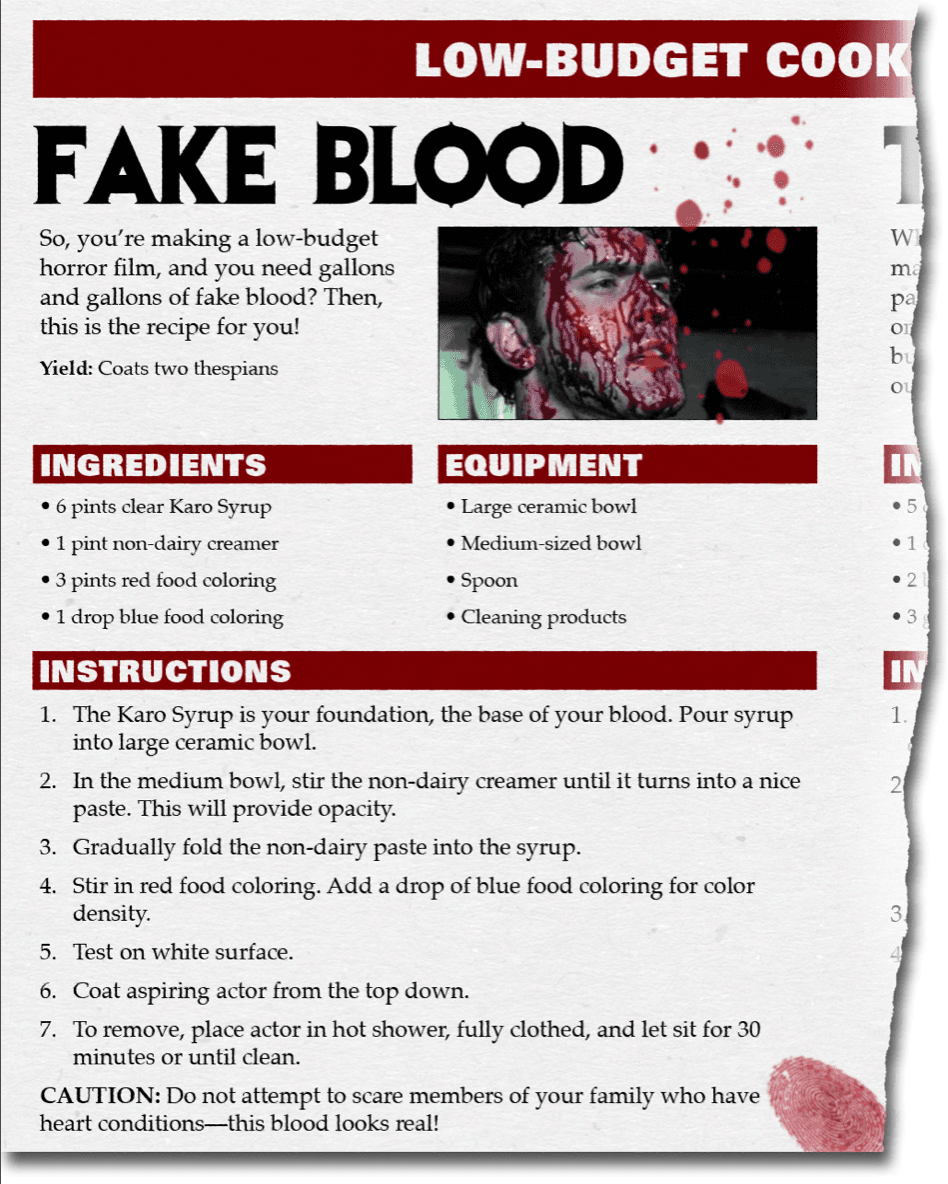
Instructions:
- In a large mixing bowl, combine the non-dairy creamer, water, and red and blue food coloring. The goal here is to create a smooth paste and slowly all of the remaining water without leaving any dry clumps or lumps.
- Slowly add the corn syrup, continuing to stir as you do so that the corn syrup is completely integrated without lumping or clumping.
- Test the consistency on a piece of scrap cloth and the back of your hand for color and texture. Consider adding additional water if the solution is too thick.
Magic Blood
A+B Blood
This is a spectacular trick that allows for knife wounds and other situations where contact triggers the appearance of blood. This fake blood effect will require that you buy some items probably not available at your local grocery store, but can be easily found online.
A+B Blood Recipe
- 25 g potassium thiocyanate
- 5 g ferric chloride (iron(III) chloride)
- salt
- water
- sodium fluoride (optional)
Instructions:
- Using separate containers or cups, mix about 25 grams of potassium thiocyanate with 100 milliliters of water (solution A), and in another container, mix 5 grams of ferric chloride with 100 ml of water (solution B). Add the lecithin, red, and yellow food colors and continue to mix
- Add a pinch of salt to each to create a saturated solution.
- At this point, both solutions will be fairly clear and invisible when added to skin or an object. Dip a prop knife into solution A and a piece of cloth or cotton ball in solution B.
- Wipe solution B onto the skin where the cut will take place, then drag the prop knife across the skin. When the chemicals come into contact, they will turn bright blood red.
This effect can also be used with paper and an actor’s fingertip to create the impression of writing in blood.
SAFETY: Be sure to keep both chemicals away from the eyes and the mouth; this is not an edible concoction.
If you can’t find the raw ingredients for this trick online, you can buy the pre-made solutions from Roger George Special Effects or MTFX.
Off the Shelf Options
Alternatives to DIY Fake Blood
Sometimes, you just don’t have time or can’t get the right look with DIY fake blood recipes, but luckily, there are off-the-shelf options that can give you realistic fake blood without breaking the bank.
FAKE BLOOD SUPPLIERS
Roger George Special Effects: Located in Van Nuys, Roger George has been supplying Hollywood with all kinds of special effects equipment for over forty years.
Ben Nye Makeup: Ben Nye, established by a former Hollywood makeup artist, provides an extensive range of makeup and special effects products. Among their exceptional offerings is the highly sought-after Stage Blood.
Alcone Company: Since its establishment in 1952, Alcone has been providing a diverse selection of stage makeup and special effects products. Among its offerings is a notable inclusion of fake blood, catering to the needs of performers and production teams alike.
Mouldlife: Mouldlife, a UK-based company that specializes in special effects materials, offers a wide range of fake blood options, including a blood formula called Kensington Gore.
BLOOD OVERLAYS
We have a wide variety of blood VFX stock footage that is easy to use and produces extremely realistic results.
Conclusion
The quest for realistic yet practical fake blood has driven innovation in filmmaking for over a century. From early theatrical concoctions to advanced digital effects, cinematic blood has evolved dramatically while remaining based on simple core ingredients.
Glycerin, syrups, and food dyes form the foundation of most blood recipes for their viscosity, gloss, and vivid coloring. Thickeners like cornstarch and creamer lend opacity and coagulation effects. Oils and emulsifiers enable convincing flow and dripping.
Yet, as recipes improve, new challenges arise. Safety standards have risen to limit toxicity. Censorship boundaries continue shifting. Audience tastes change over time. Blood’s effectiveness relies on skillful use within a wider dramatic context.
Filmmakers must constantly balance realism, safety, artistry, and ethics when unleashing blood’s visual power. But its primal emotional impact remains unparalleled. As fake blood enters its next century, this potent cinematic symbol will continue evolving while remaining integral to the language of film.
FAQs
What materials make safe fake blood for film?
Edible ingredients like corn syrup, food coloring, and thickeners such as cornstarch make relatively safe, non-toxic blood. Other key components are glycerin for viscosity and mint oil for taste. Avoid ingredients that could irritate the eyes or stain the skin.
How do you make blood look realistic on black & white film?
Darker, opaque liquids like chocolate syrup photograph convincingly as blood in black and white. The gloss and thickness of chocolate syrup replicate the look of blood without worries about color tone.
What recipe was used for the blood in the famous elevator scene in The Shining?
The blood in that iconic scene was an updated version of the syrup-based recipe known as Kensington Gore. Stanley Kubrick was known for using this classic formula developed in England for horror films.
How do you clean up fake blood spills from filming?
Shaving cream can help dissolve syrup-based blood for cleanup. Quick cleanup is key before staining sets in. Avoid abrasive chemicals that could damage skin, and wear old clothes to limit stains.

